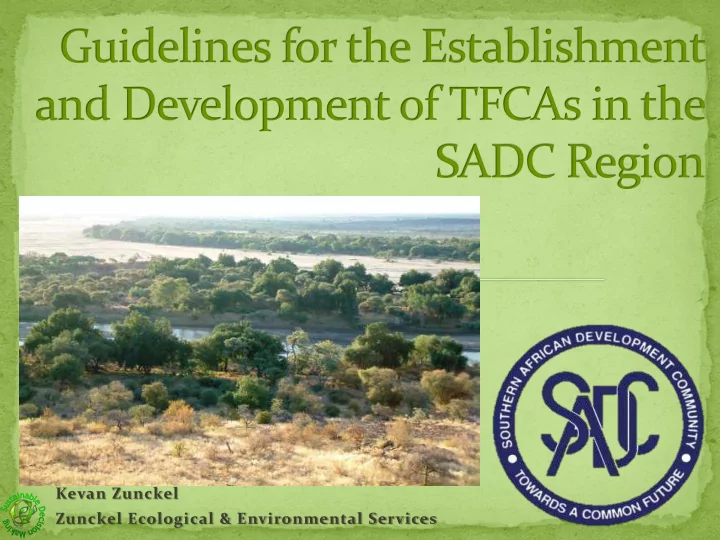

Kevan Zunckel Zunckel Ecological & Environmental Services
Highly consultative team approach: • Workshop #1: Johannesburg – presentation of draft Table of Contents, invitation to participate and establishment of a reference group. • Workshop #2: Luanda – develop content. • Workshop #3: Maseru – validation of content and identification of case studies.
Niel Lubbe , Lecturer at the Faculty of Law at the North West University, South Africa, for compiling the sections related to the legal and policy framework. Piet Theron , International Coordinator for the Great Limpopo Transfrontier Park, who compiled Section 4.8. and provided critical review. The Peace Parks Foundation for providing access to information and in particular the summary of their Performance Appraisal Tool. Col. David Peddle , previously with the South African National Defence Force on issues related to cross border security. Dr Tamar Ron , UNDP Biodiversity Chief Technical Advisor for The Ministry of Environment of Angola, who provided information on the Mayombe Forest TFCA. Prof Andrew Nambota , Director: TFCA, Ministry of Tourism and Arts, Zambia for information on the ZIMOZA and Liuwa Plains – Mussuma TFCAs. Humphrey Nzima , International Coordinator, Malawi Zambia Transfrontier Conservation Area, for the joint law enforcement case study. Leseho Sello , International Coordinator, Lubombo Transfrontier Conservation Area, for inputs on this TFCA. Clara Bocchino , AHEAD-GLTFCA Coordinator, for critical review of a draft. Dr Bartolomeu Soto , SADC Technical Advisor and project supervisor, for critical review of drafts and implementation support.
1. Benefits beyond boundaries: a. Tangible b. Ensure socio-economic relevance 2. Pillars of sustainability: a. Effective governance b. Persistent biodiversity features and functional ecosystems c. Social relevance d. Economic viability
1. Introduction 2. PART I – Background and Contextual Information 3. PART II – Initiation Processes 4. PART III – Establishment and Development Processes 5. ANNEXURES: A. The Guideline Compilation Process B. The potential benefits of TFCA initiatives C. Examples of Ecosystem Goods and Services D. Background information on existing SADC TFCAs E. Diagnostic tool for transboundary conservation planners F. Performance Appraisal Tool
Introduction 1. A Brief Historical Perspective on SADC TFCAs 2. The Aim of these Guidelines 3. The Guideline Principles 4. The Intended Audience of these Guidelines 5. The Guideline Compilation Process 6. The Structure of the Guidelines
PART I – Background and Contextual Information 1. Definitions 2. The Legal and Policy Framework 3. The Value of Transfrontier Conservation for SADC Member States 4. The Status Quo of Transfrontier Conservation Areas in the SADC Region
PART II – Initiation Processes 1. Stakeholders and Role Players Relevant to the SADC Context 2. Assessing the Enabling Environment – pre-feasibility 3. Assessing TFCA Feasibility (Diagnostic tool for transboundary conservation planners http://www.tbpa.net/page.php?ndx=22) 4. Designing the Implementation Process
PART III – Establishment and Development Processes 1. Securing buy-in and building legitimacy 2. Select an appropriate governance model 3. Defining the Geographic Extent 4. Developing the Framework for Joint Management 5. Refining the Joint Management Framework 6. Planning for Financial Sustainability 7. Monitoring and Evaluation
General perception of SADC TFCAs: • Regional approach • Opportunistic • Largely driven at the political level – top down • Donor dependent • Few objective feasibility assessments supporting initiation and establishment • Limited demonstration of tangible benefits • Guidelines mostly need to be applied retrospectively • Limited uptake and application of guidelines despite collaborative compilation
• International coordinators to facilitate a process of mainstreaming the guidelines into their planning and management. • Apply the guidelines as a checklist to assess initiation, establishment and management effectiveness. • Provide critical feedback for the possible revision and updating of the guidelines by 2025.
Recommend
More recommend